A proper, Canada-wide consultation, of key stakeholders, including affected communities, First Nations, provincial and territorial governments, and the key departments and agencies with the responsibility of conducting environmental assessments was not done.
The Federal Government intends to make sweeping and substantial changes to the regulatory approvals system for major resource projects, but provides no needed details as part of the review .
- lack of clarity on process and
- lack of evidence on which to base the conclusions and recommendations of the report.
- Omnibus Budget Implementation Act 2010 amendments to the CEAA, included exemptions for certain projects and provisions granting the Minister of Environment power to limit the scope of assessments, were not considered during the Committee’s review of the Act.
Lack of Clarity on Process
- inadequate time to prepare written and oral submissions and an idea of the scope and objectives of the legislative review.
- it was left unclear what aspects of the environmental assessment regime the committee aimed to study.
Lack of Evidence
- the truncated, unfocused hearing process, testimony from important stakeholders and experts was curtailed or absent from the study.
- Numerous government departments and agencies were not heard from during the review.
Fundamental Flaws in the Report
Not raised in the findings of the report.
-assessment tools such as strategic and regional assessments,
-the need for cumulative impact assessment,
-meaningful public participation, participant funding, and the
-importance of and duty to consult First Nations,
-funding for the Canadian Environmental Assessment Agency,
Inappropriate citations, as justification for conclusions, statements made by Committee
members.
It focused primarily on efficiency and reduced timelines.
(1) a framework was not developed using a systematic method from the testimony heard (i.e. the process was not an evidence-based approach);
(2) testimony was limited;
(3) the report does not accurately reflect all views presented by witnesses,
(4) testimony regarding the environment and the need for better protection is largely not included in the report.
How will `significance` be defined? - an evidence-based approach was not used,
and hence, the scope of the study, and stakeholders from whom we heard, were limited.
(1) possible reduced public participation in any environmental assessment, which we would see as undemocratic, unfortunate, and poor for the economy, environment, and society;
(2) possible reduced Aboriginal consultation (e.g. Recommendation 15 says, ``streamline aboriginalconsultation``), which we would consider a breach of duty to consult, and completelyunacceptable; and
(3) possible increased ministerial powers - we run the risk of loss of natural life support systems and other ecosystem failures. Now a risk of slowing down the process through possible conflicts and lawsuits, especially where constitutional rights and public concerns are not adequately addressed.
Elizabeth May's take:
http://elizabethmaymp.ca/news/publications/articles/2012/03/21/no-government-has-a-mandate-to-destroy-our-natural-world/
No government has a mandate to destroy our natural world
We are now fighting a rear-guard action against losing all the laws we have.
For the last forty years or so, any paper on environmental policy could
be forward-looking. The steady, if lamentably slow, process of
developing environmental law and policy has been advancing since 1970
and the creation of Environment Canada.
Canada was slower than the United States. Under the Nixon presidency,
the US passed the National Environmental Policy Act, the Endangered
Species Act, the Clean Water Act, the Clean Air Act and laws governing
environmental assessments.
It took Canada several decades more to develop less robust laws, with
the heavy lifting done in the Mulroney era with the Canadian
Environmental Protection Act, the creation of the National Round Table
on Environment and Economy, and the launching of the Canadian
Environmental Assessment Act.
The CEAA ultimately came into effect once Jean Chrétien had become prime
minister, and it was Chrétien who brought in the Environmental
Commissioner, within the office of the Auditor General, as well as the
Species at Risk Act.
I would love to write an article setting out where the country needs to
go to advance better environmental law and policy. However, we are now
fighting a rear-guard action against losing all the laws we have. Not
only is the CEAA process under assault, but so too are the habitat
protection provisions in the Fisheries Act.
The attacks on the environmental assessment process have been
unrelenting. First, the Harper government weakened it in the 2010
omnibus budget bill. By attaching wholesale changes to environmental law
to the budget bill, it was forced through, without benefit of hearings
or public outrage.
Sadly, opposition parties at the time were more afraid of an
inconvenient election than they were dedicated to preserving
environmental law. The 2010 omnibus budget bill savaged the CEAA by
taking energy projects out of its jurisdiction and weakening
comprehensive study. The next move to hogtie environmental review was to
cut CEAA’s budget by 40 per cent.
Last week, the House environment committee issued a pre-ordained set of
recommendations to further destroy environmental review.
Under the CEAA, every five years there is a mandatory review of the Act.
In 2000, the review took over a year; hearings were held across the
country; the process ran from January 2000 to March 2001.
This time, the committee pulled the plug after hearing witnesses for
nine days. That’s right—the previous government studied the law for 15
months, and the Conservatives didn’t give it 15 days.
Many witnesses, who had been informed they would be heard, were turned
away. I thought at the time that the Prime Minister’s Office must have
told the Conservatives who control the committee to deliver ASAP a
report to gut the process. And they did.
I fear that the sweeping changes—removing the CEAA’s jurisdiction from
any province with “equivalent” environmental assessments, removing the
requirement to consider alternatives, ordering fixed timelines for
reviews, giving the minister increased powers, “streamlining” First
Nations consultations—all point toward more nails in the CEAA’s coffin.
A few days after the recommendations to emasculate the CEAA process,
Fisheries Minister Keith Ashfield confirmed in the House that the
Fisheries Act is also targeted for massive erosion.
The Fisheries Act, with its origins in the earliest days of Canada, is
the strongest environmental law we have in Canada; now the minister
appears set to remove the sections of the Act that prohibit the
destruction of fish habitat.
We are also hearing that the protection of fish, a constitutional area
of federal responsibility, is to be weakened. Only fish of “economic,
cultural, or ecological value” will be protected. No one knows what that
means.
We do know that none of this is coming from the scientists at the
Department of Fisheries and Oceans. It is not coming from the minister
either. Just like the Environment committee report, this appalling
change has PMO fingerprints all over it.
It is clear that Stephen Harper has one burning desire; one unalterable
vision. It is of six million barrels of oil a day coming out of the oil
sands. He wants it dug out, pumped out, or steamed out, and turned into
a form of bitumen crude capable of flowing in a pipeline to get it to
refineries, preferably outside of Canada.
The prime minister has promised a foreign power, none less than the
government of China, that its state-owned oil enterprises with profits
that flow to the state and its military, will have its pipeline built
through northern British Columbia. He has promised that oil supertankers
will chart the most treacherous waters on the planet, ignoring a tanker
ban that has been in place since 1972.
All this has he promised. And what stands in his way? Fish habitat and
the laws that protect it, as well as hundreds of streams and lakes
between the oil sands and Kitimat, BC.
As well, he is apparently untroubled by the opposition of dozens of
First Nations, nor by the fiduciary duty he holds to protect First
Nations constitutionally-enshrined aboriginal rights. Nor does it enter
his calculus that 80 per cent of British Columbians oppose opening the
coast to tanker traffic.
After 35 years of working on environmental assessments, I am watching
the current government weaken the process to less than what we had in
1970. No government has a mandate to undo environmental law. No
government has a mandate to destroy our natural world.
Elizabeth May is the leader of the Green Party of Canada and the Member
of Parliament for Saanich—Gulf Islands.
Originally printed in Embassy Magazine
Subscribe to:
Post Comments (Atom)
Useful Links
- Mount Gox - Bitcoin exchange
- Reggie Middleton's Rapier Analysis
- Ontario Rivers Alliance
- Geodesic Dome Construction
- Canadian Disaster Preparedness
- Globe and Mail
- Chris' The Weekly Telegram
- Michael Rupert of CollapseNet
- Max Keiser
- Nicole Foss Blog - the automatic earth
- Peak Moment Discussions
- Scotia Mocatta Bullion Store
- Dimitry Orlov - Peak Moment Discussions
- Jims's ISFCR Blog
- Jenny Right Side Blog
- Scott Sorensen
Alternative Energy Sites I like
The Queen is not amused!
http://www.ispeakforcanadianrivers.ca/
The Ashlu river: it could happen to you

Whitewater Ontario

Working Hard to Protect Canada's Paddling Resources
Whitewater Ontario - Mission Statement
It is Whitewater Ontario’s mission to support the whitewater paddling community through the promotion, development and growth of the sport in its various disciplines.
We accomplish this through the development of events, resources, clubs, and programs for personal and athletic development, regardless of skill level or focus, to ensure a high standard of safety and competency;
We advocate safe and environmentally responsible access and use of Ontario’s rivers.
Whitewater Ontario is the sport governing body in the province, and represents provincial interests within the national body Whitewater Canada and the Canadian Canoe Association
http://www.whitewaterontario.ca/page/mission.asp
Kipawa, Tabaret, and Opemican
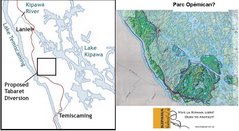
If Hydro Quebec is not actively pursuing Tabaret what is that bite out of Opemican for?
Kipawa Dam: After

Laniel Dam at 2006 Rally
Where is the Kipawa
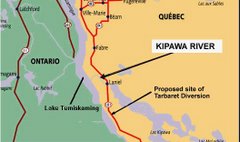
Kipawa flows into lake Temiskamingue, running from Kipawa Lake, under hwy 101 in Quebec
Kipawa Dam

laniel dam at 2004 River Rally
Tabaret is a Bad Idea
About the Kipawa
The best thing paddlers can do to help the cause of the Kipawa:
1. attend the rally and bring others including non paddlers to attend and buy beer and have fun
2. write your MP /MNA and raise the issue and post your objections -1 letter = 200 who didn't write
3. Write Thierry Vandal the CEO of Hydro Quebec strongly opposing the 132 MW standard decrying the use of "diversion" as the most environmentally inappropriate method of power production
4. Write Jean Charest, Premier of Quebec protesting that either the algonquin or the tabaret project will eliminate all other values on the Kipawa River by turning it into a dry gulch.
5. See if you can get other allied groups interested by showing your own interest, ie the Sierra Defense Fund, Earthwild, MEC, and so on.
6. Demand further consultation
7. Currently we are at the point where we need to sway public opinion and raise awareness.
However, if all else fails, don't get mad, simply disrupt, foment, and protest . The Monkey Wrench Gang.
Have you read Edward Abbey?
Important Addresses
CEO,Hydro Québec, 75 boul René Levesque, Montreal, P.Q., H2Z 1A4Caille.andre@hydro.qc.ca
The best thing paddlers can do to help the cause of the Kipawa:
1. attend the rally and bring others including non paddlers to attend and buy beer and have fun
2. write your MP /MNA and raise the issue and post your objections -1 letter = 200 who didn't write
3. Write Thierry Vandal the CEO of Hydro Quebec strongly opposing the 132 MW standard decrying the use of "diversion" as the most environmentally inappropriate method of power production
4. Write Jean Charest, Premier of Quebec protesting that either the algonquin or the tabaret project will eliminate all other values on the Kipawa River by turning it into a dry gulch.
5. See if you can get other allied groups interested by showing your own interest, ie the Sierra Defense Fund, Earthwild, MEC, and so on.
6. Demand further consultation
7. Currently we are at the point where we need to sway public opinion and raise awareness.
However, if all else fails, don't get mad, simply disrupt, foment, and protest . The Monkey Wrench Gang.
Have you read Edward Abbey?
Important Addresses
CEO,Hydro Québec, 75 boul René Levesque, Montreal, P.Q., H2Z 1A4Caille.andre@hydro.qc.ca
Tabaret is a Bad Idea (Part Two)
Les Amis de la Riviere Kipawa is poised to use an application to the Federal Court to issue a Writ of Mandamus to ensure the Minster does what he is supposed to do, protect the public's right to navigate the water control structure at Laniel, Quebec using the Navigable Waters Protection Act. (see http://www.kipawariver.ca/)
In the now gutted Navigable Waters Protection Act lay the means by which the Minister of Transport could keep the public right of passage down our great Canadian Heritage, our rivers and streams which are threatened especially by resource corporations and power brokers such as Hydro Quebec.
These powerful entities continue to petition that 'this' river or 'that' stream is not navigable and therefore not protectable.
I don't say that dams and bridges should not be built, only that if they are, historical navigation rights should be considered and preserved by making reasonable accommodations for recreational boaters.
It is the Minister of Transport, in exercising the right to allow or disallow work on or over a navigable waterway is what keeps boats and recreational boaters plying our waterways.
To many recent cases launched in the Federal Court concerning the Navigable Waters Protection Act, most recently the case of the Humber Environment Group of Cornerbrook Newfoundland versus the Cornerbrook Pulp and Paper Company indicates that the important oversight is not being faithfully performed. Have we really come to the point now where we must say "such and such a stream is one foot deep, possessing so many cubic feet per second flow and so on?" The answer to this is... YES!
The honourable Mr. Justice John A. O'Keefe, ruled that it had not been shown that the river was navigable. How convenient was that to the Minister? But either the Minister of Transport acts to protect our rivers and streams as a public right or he does not and that means rivers and streams currently enjoyed by kayakers and canoists.
Enough of the cheating, and double-talk. Canadians! our rivers and streams are our own, lets urge the Minister of Transport and the our government to protect them.
Peter Karwacki
In the now gutted Navigable Waters Protection Act lay the means by which the Minister of Transport could keep the public right of passage down our great Canadian Heritage, our rivers and streams which are threatened especially by resource corporations and power brokers such as Hydro Quebec.
These powerful entities continue to petition that 'this' river or 'that' stream is not navigable and therefore not protectable.
I don't say that dams and bridges should not be built, only that if they are, historical navigation rights should be considered and preserved by making reasonable accommodations for recreational boaters.
It is the Minister of Transport, in exercising the right to allow or disallow work on or over a navigable waterway is what keeps boats and recreational boaters plying our waterways.
To many recent cases launched in the Federal Court concerning the Navigable Waters Protection Act, most recently the case of the Humber Environment Group of Cornerbrook Newfoundland versus the Cornerbrook Pulp and Paper Company indicates that the important oversight is not being faithfully performed. Have we really come to the point now where we must say "such and such a stream is one foot deep, possessing so many cubic feet per second flow and so on?" The answer to this is... YES!
The honourable Mr. Justice John A. O'Keefe, ruled that it had not been shown that the river was navigable. How convenient was that to the Minister? But either the Minister of Transport acts to protect our rivers and streams as a public right or he does not and that means rivers and streams currently enjoyed by kayakers and canoists.
Enough of the cheating, and double-talk. Canadians! our rivers and streams are our own, lets urge the Minister of Transport and the our government to protect them.
Peter Karwacki
Tabaret is a Bad Idea (Part Three)
10 Reasons WhyTabaret is a Bad Idea1) Tabaret is too big. The station is designed to useevery drop of water available in the Kipawawatershed, but will run at only 44 percent capacity.We believe the Tabaret station is designed to usewater diverted from the Dumoine River into theKipawa watershed in the future.
2) The Tabaret project will eliminate the aquaticecosystem of the Kipawa River.The Tabaret project plan involves the diversion of a16-km section of the Kipawa River from its naturalstreambed into a new man-made outflow from LakeKipawa.
3) Tabaret will leave a large industrial footprint on thelandscape that will impact existing tourismoperations and eliminate future tourism potential.
4) The Tabaret project is an aggressive single-purposedevelopment, designed to maximize powergeneration at the expense of all other uses.
5) River-diversion, such as the Tabaret project, takinglarge amounts of water out of a river’s naturalstreambed and moving it to another place, is verydestructive to the natural environment.
6) The Kipawa River has been designated a protectedgreenspace in the region with severe limitations ondevelopment. This designation recognizes theecological, historical and natural heritage value ofthe river and the importance of protecting it.Tabaret will eliminate that value.
7) If necessary, there are other, smarter and morereasonable options for producing hydro power onthe Kipawa watershed. It is possible to build a lowimpactgenerating station on the Kipawa river, andmanage it as a “run-of-the-river” station, makinguse of natural flows while maintaining other values,with minimal impact on the environment.
8) The Kipawa watershed is a rich natural resource forthe Temiscaming Region, resonably close to largeurban areas, with huge untapped potential fortourism and recreation development in the future.Tabaret will severely reduce this potential.
9) Tabaret provides zero long-term economic benefitfor the region through employment. The plan is forthe station to be completely automated andremotely operated.
10) The Kipawa River is 12,000 years old. The riverwas here thousands of years before any peoplecame to the region. The Tabaret project will change all that.
Problems on a local River?
- There is more to do as well but you have to do your research and above all, don't give up.
- IN the meantime prepared a document itemizing the history of navigation of this spot and its recreational value. Use the Kipawa river history of navigation as a guide: see www.kipawariver.ca
- Under the Ministry of Environment guidelines you have a set period of time to petition the change under the environmental bill of rights, you may have limited time to take this action. But it involves going to court for a judicial review of the decision.
- 4. contact the ministry of natural resources officials and do the same thing.
- 3. contact the ministry of the environment and determine if they approved the project
- 2. determine if the dam was a legal dam, approved under the navigable waters protection act.
- 1. research the decision and timing of it to determine if an environmental assessment was done.
Minden Ontario
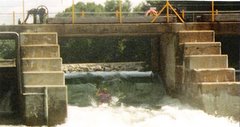
Gull River Water control at Horseshoe lake
A History of Navigation on the Kipawa River
Prior to the environmental assessment there was no signage at the Laniel Dam
T-Shirts Area: These are available now!

Send $25 and a stamped self addressed envelop for the Tshirt, and for the bumper sticker, a stamped and self addressed envelope with $5.00 for the bumper sticker to Les Amis de la rivière Kipawa, 80 Ontario St., Ottawa, Ontario, K1K 1K9 or click the link To purchase a Les Amis "T" contact Doug with the following information: Number of shirts:Sizes: Ship to Address: Method of Payment: cash, cheque and paypal, Shipto address:
Bumper Stickers Now Available

Get your bumper sticker and show your support for the Kipawa Legal Fund ! - send $5.00 in a Stamped, self addressed envelope to: Peter Karwacki Box 39111, Ottawa, Ontario, Canada, K1H 7X0
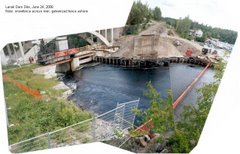


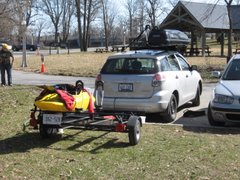

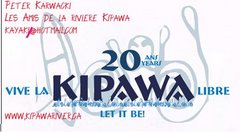
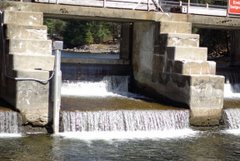


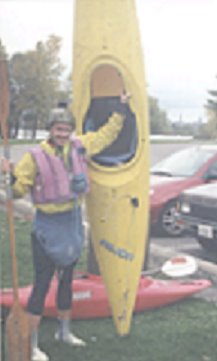



No comments:
Post a Comment